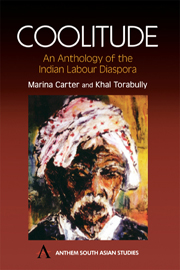Book contents
- Frontmatter
- Contents
- Introduction
- The Coolie Odyssey: A Voyage In Time And Space
- Thrice Victimized: Casting The Coolie
- Surviving Indenture
- Reclaiming The ‘Other’: Diaspora Indians And The Coolie Heritage
- Some Theoretical Premises Of Coolitude
- Conclusion: Revoicing the Coolie
- Poetic And Critical Texts Of Coolitude
- Notes
- Bibliography
Introduction
Published online by Cambridge University Press: 05 March 2012
- Frontmatter
- Contents
- Introduction
- The Coolie Odyssey: A Voyage In Time And Space
- Thrice Victimized: Casting The Coolie
- Surviving Indenture
- Reclaiming The ‘Other’: Diaspora Indians And The Coolie Heritage
- Some Theoretical Premises Of Coolitude
- Conclusion: Revoicing the Coolie
- Poetic And Critical Texts Of Coolitude
- Notes
- Bibliography
Summary
The forced diaspora of African slaves has generated a veritable media industry. The imagery of the chained man, of the brutalized woman, of the kidnapped child has held our attention for several centuries. The dehumanization of the slave cast its shadow over succeeding generations, whose attempt to refashion their own history is illustrated in the ‘négritude’ movement. However, the recognition of a black identity did not fully take into account the ethnic complexity of post abolition societies that developed in the Caribbean and Indian Ocean. Creolité, antillanité and Indienocéanisme are among the more ethnically inclusive movements that have emerged to replace négritude. The dissemination of Indian labour throughout the nineteenth century British Empire has lacked a defining element until now. The concept of coolitude is designed to fill that lacuna, to describe and encapsulate the distinctive characteristics of the streams of indentured migration which have decisively shaped modern nations such as Mauritius, Trinidad, Guyana, Fiji and influenced others like Guadeloupe, Martinique, East and South Africa.
From Négritude to Créolité
Black US intellectuals like W E B Du Bois and Booker T Washington are credited with the commencement of black studies. Activists, like Marcus Garvey, took up their work whose stand against discrimination and injustice gave a new drive to the movement of black consciousness. Négritude is the francophone equivalent, and dates from the launch of L'Etudiant Noir in 1934 by Aimé Césaire, Léopold Sedar Sengor and Léon Gontran Damas.
- Type
- Chapter
- Information
- CoolitudeAn Anthology of the Indian Labour Diaspora, pp. 1 - 16Publisher: Anthem PressPrint publication year: 2002



